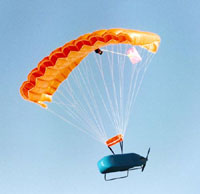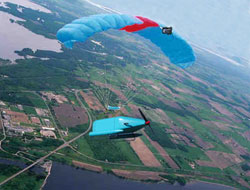recovery location). Otherwise
the system can delivery its payload directly by landing at the user
designated location from which both the cargo and the system can be
retrieved.
Recoverable/reusable
The greatly enhanced range of the powered
system provides the user with enhanced operational flexibility when
choosing recovery locations.
Flexible deployment
This highly versatile system can be air
deployed from numerous cargo aircraft including the C-130, C-141, CH-47
and C17, as well as ground deployed from a ground launch vehicle.
The combination of air and ground
deployment offers maximal deployment flexibility. In effect, the system
can be deployed from any location on the ground accessible to a Hummer,
or from any location in the air accessible by cargo aircraft.
Standard rigging techniques
When deployed from a cargo aircraft, the
system is packed and rigged using standard parachute packing and rigging
techniques. The system is manually dispatched from the cargo aircraft and
features a static line that deploys a drogue. A mechanical latch
controlled by the airborne guidance unit, releases the main canopy
following a stabilization period under drogue fall.Pyrotechnic cutters
are not required by this system.
During a ground launch, the fully
rigged canopy is unfolded and held in position by two individuals prior
to take off. As the launch vehicle accelerates from rest, the canopy
fills and rises to its take off position.
Robustness and recovery
The system is designed not only to endure
the operational loads of air deployment and landing, it is also designed
to endure the far more stringent shock and vibration loads associated
with system recovery using a wheeled vehicle over rough terrain. |





